“The two recent issues, Sabarimala and Jallikattu, … calls for a background check, because we need to exercise discrimination when we approach a matter of faith, whereas reason is enough to resolve all other matters. Especially so, because Hindu reforms invariably seem to attract Constitutional activists from every nook and corner to demand equal rights for all and sundry, including those who have nothing to do with the event or tradition, purely motivated by political considerations. … We should exercise caution and restraint while dealing with faith, at least for now.” – George Augustine
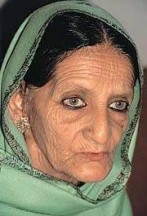 When religious reforms become the responsibility of the legislature and the judiciary in India it always ends up maintaining the status quo, without any redressal of the aggrieved party, whoever may that party be. Constitutional rights rarely carry force in India, particularly when they come to face religious injunctions and customs. The Shah Bano case and the subsequent enactment of a new law by the Rajiv Gandhi government had clearly demonstrated nearly three decades ago that the Constitutional rights of Muslim women to enjoy equality in marriage are ultimately subservient to Muslim personal law, no matter what the judiciary thinks. The same applies to the Christian inheritance law which discriminates against Christian women despite the Mary Roy case. In this regard, their Indian compatriots, the Hindu women are better off in terms of personal law.
When religious reforms become the responsibility of the legislature and the judiciary in India it always ends up maintaining the status quo, without any redressal of the aggrieved party, whoever may that party be. Constitutional rights rarely carry force in India, particularly when they come to face religious injunctions and customs. The Shah Bano case and the subsequent enactment of a new law by the Rajiv Gandhi government had clearly demonstrated nearly three decades ago that the Constitutional rights of Muslim women to enjoy equality in marriage are ultimately subservient to Muslim personal law, no matter what the judiciary thinks. The same applies to the Christian inheritance law which discriminates against Christian women despite the Mary Roy case. In this regard, their Indian compatriots, the Hindu women are better off in terms of personal law.
 Legality of reform
Legality of reform
However, all too often, Hindu religious customs and traditions are often raked up to point out all sorts of injustices done to women as well as animals. Let us say, the general Indian media is more concerned and preoccupied with Hindu religious and social practices than with Muslim or Christian practices. Muslim women are generally not allowed into mosques and Christian women can never aspire to become Catholic priests. But these things rarely come to court or are discussed. Thus, there is a long journey ahead for all of us in India to arrive at full justice, whether we are Hindus or Muslims or Christians.
India has come a long way from independence and our women are slowly getting footholds in the social and political landscape and they are getting assertive to demand equal opportunities and consideration in the religious sphere as well. It is a just demand and it is the obligation of all people in charge to do whatever there is to do to realise their aspirations as soon as possible. There is nothing in the way, but the political will and determination on the part of the current government to level the ground between men and women regardless of their religions, for which the Uniform Civil Code is a prerequisite. Under the current political dispensation there is no indication of any positive light, but we can still go on hoping towards a just and fair India sooner than later.
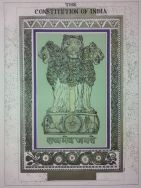 Faith versus democracy
Faith versus democracy
The two recent issues, Sabarimala and Jallikattu, taken up by our Supreme Court calls for a background check, because we need to exercise discrimination when we approach a matter of faith, whereas reason is enough to resolve all other matters. Especially so, because Hindu reforms invariably seem to attract Constitutional activists from every nook and corner to demand equal rights for all and sundry, including those who have nothing to do with the event or tradition, purely motivated by political considerations. It is a good trend that we have so many people cheerleading our good Constitution whatever may be their motive, but we should exercise caution and restraint while dealing with faith, at least for now.
Faith is an untouchable in our country. No one can question it, no matter what kind of faith. However, in the past, many Hindu ‘traditions’ like sati, child marriage, devadasi systems have been put to sleep through legislation. Some of them caused harmful side effects and adverse consequences for many involved, but at least some of them were carried out in good faith and the communities have benefitted too to a certain extent. So, by precedent, Hindu traditions are open, dynamic and flexible to change unlike the Abrahamic traditions of Islam and Christianity, which are more ideologies than religions and have remained rigid and ossified in their fundamentals since their inception in the stone-age period of civilisation.
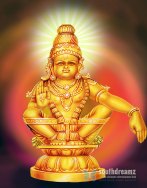 Sabarimala
Sabarimala
Sabarimala is one of the oldest shrines in Kerala with a unique tradition. There are many such singular temples in Kerala (Chakkulathu Kavu and Attukal Bhagavathi Temple) and each of them keeps its uniqueness by adhering to the peculiar customs and traditions followed for at least more than a millennium. Sabarimala temple is one of the five Sastha temples in Kerala, each of the five housing the deity in a certain stage of human life: Kulaththupuzha Temple housing an infant Sastha, Aryankavu housing an adolescent, and at Achankovil as the householder (grihasthashrami) with his wives Poorna and Pushkala and at Erumeli as Dharma Sastha.
Sastha is consecrated at Sabarimala as “naishtika brahmachari” (persistent ascetic) in a state of samadhi, and is believed to have been established by the legendary Parasurama. To agnostics, this might appear to be obsolete and irrelevant, but remember, this is the realm of belief and faith. A murthi inside the sreekovil in a particular temple is consecrated according to Tantric principles, which is believed to endow certain powers to the murthi. This particular power is distinct in each consecration according to the Tantric principle used and remains with the murthi, provided that certain conditions are met by the devotees and those responsible for the temple. One of those conditions at Sabarimala is the absence of fertile women in the sannidhanam, whose presence can (in simple terms) affect the tantric energy of the murthi, making it powerless.
From time immemorial, women of child-bearing age never ventured into the thick Sabari forest to disturb the meditation of Sastha due to the prevailing belief and as a mark of respect for what Sastha was purportedly doing. It was not an easy journey then, and not very easy now even with two well-lit concrete paths. However devotees were accompanied by girls before they attained puberty and elderly women in the family on their annual pilgrimage to the shrine. Following the same tradition, all pilgrims had to undergo ascetic renunciation for 41 days before they ventured up the mountain, so that they were on an energy level conducive to Lord Sastha. This is the belief that became the basis for the control of entry of fertile women by the temple administration body, Travancore Devaswom in 1969 and later upheld by the Kerala High Court in 1991. The entry control by the administration became stringent after a dance scene was shot in the sannidhanam for a Tamil movie (Nambinar Keduvathillai) in 1986, when several actresses of fertile age were present. As a consequence, the actresses, director K. Sankar and the temple officials who granted permission were taken to court and penalised.
By the entry of fertile women into the sannidhaanam, the consecrated murthi loses its validity, according to Tantrics and believers who have been following the tradition. This kind of esoteric information is absent in the public sphere for obvious reasons, and one cannot really blame the shrill, irate women who appear on telly calling for everybody’s blood, sometimes asking foolishly for evidence of Ayyappa’s dislike for ‘menstruating’ women. People concerned (temple administration body) should pacify these women and educate them in matters of faith, if that is really what they want. If a fertile woman is a believer, she certainly ought to believe in the consecration philosophy and abide by it and make it a point to go there after menopause. If she is not a believer, why go there in the first place? There are many hilly resorts for tourists in Kerala.
Another aspect many young and ignorant women bring up is the ban on women in temples during their menstruation period. Actually there is no official ban, but only an etiquette that is as old as temple worship. Nobody is there to check whether anybody is menstruating. If it is found out later by evidence, some ritual has to be performed to recreate the pure energy. None of the temple-going women I know would ever dream of visiting a temple during their menstruation period, because they know that it is not the appropriate thing to do for reasons other than sexism [recommended reading]. But ignorance continues to make the most noise.
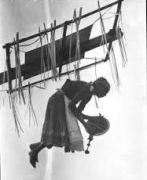 Non-tantric ritual arts and sport that come under ban
Non-tantric ritual arts and sport that come under ban
Other than the issues of modernity and age-old temples, there are folk rituals that have been affected by bans. By folk rituals, I mean non-Brahmanical ritualistic arts and sport, particularly those that have some sort of violence and pain involved, and that have been banished by modern sensibilities for better or for worse, but mostly for the worst.
An instance is a ritual called ‘Elavoor thookam‘ performed at the Elavoor Puthenkavu Bhagavathy Temple, about 40 kilometres north of Cochin, which came under ban for the first time in 1987, revived on and off and later banned again in 2004. The ritual involves the suspension of a devotee on a 32-foot cantilever arm mounted on a carriage that circumambulates the temple thrice. The suspension is implemented by two iron hooks pierced through the back skin of the devotee and is performed after several days of renunciation by the protagonist and pre-treatment of the skin with specially prepared oil for 21 days. You may see it here.
The concerned devotees who have undertaken the thookam proclaim there is no pain involved and reportedly there are persons who have done this multiple times and still living and evidently without any ill effect. However the opponents of the thookam who wanted the ban and secured it say there have been accidents in the past, but none mention any accidental death. In the run up to the second ban in 2004, when the then temple advisory committee wanted to revive the ritual, the Tantrics responsible for the temple were consulted and they proclaimed the ritual was not tantric, hence not scriptural and not indispensable for the functions of the temple. Many Hindu organisations opposed the ritual and prominent among the personalities who led the movement for the ban were Swami Bhoomananda Tirtha of Narayanashrama Tapovanam in Kerala and Kummanam Rajasekharan, the present President of the BJP in Kerala.
After the ban by the district collector, the pro-thookam agitators were disappointed but equally adamant in reviving their ritual, which they say is several centuries old. One of the most important reasons the opposing Hindu group cited was that the ritual was a “vestige of human sacrifice” and that the present ritual was “barbaric”. To be honest, the ritual is a version of the “full body suspension” currently practised by “body artists” in Europe and the USA. I personally know a German artist who told me the suspension is entirely painless, and the element of risk is carried by the person who pierces the hook, which makes all the difference. Fatalities can be entirely ruled out due to the medical assistance at hand. There are more dangerous sporting events like motor racing or the extreme sports, where mistakes are too expensive.
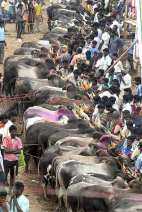 The strongest argument I’ve heard in favour of the jallikattu is the variety of native cattle breeds nurtured and conserved by this one single annual event. No doubt it was also a major sporting event in ancient India and also significant in terms of social anthropology, and it is not anything to be scorned or insulted, but respected. The worst feature of jallikattu is the toll of deaths (reportedly 200 in the last two decades) and injuries sustained by people as well as by the animals. We can forget the death toll of humans, because they decide for themselves unlike the poor bulls, which are fed and nurtured by their rich owners but treated cruelly to make them agitated and ferocious for the festival. Jallikattu is likely to vanish just like Elavoor thookam unless a congenial solution is found among the organisers. In a combative atmosphere, where Hindus are divided, politics will creep in and vested interests will make sure that priceless cultural assets are destroyed.
The strongest argument I’ve heard in favour of the jallikattu is the variety of native cattle breeds nurtured and conserved by this one single annual event. No doubt it was also a major sporting event in ancient India and also significant in terms of social anthropology, and it is not anything to be scorned or insulted, but respected. The worst feature of jallikattu is the toll of deaths (reportedly 200 in the last two decades) and injuries sustained by people as well as by the animals. We can forget the death toll of humans, because they decide for themselves unlike the poor bulls, which are fed and nurtured by their rich owners but treated cruelly to make them agitated and ferocious for the festival. Jallikattu is likely to vanish just like Elavoor thookam unless a congenial solution is found among the organisers. In a combative atmosphere, where Hindus are divided, politics will creep in and vested interests will make sure that priceless cultural assets are destroyed.
The best way out of such precarious situations is the reformation of the sport or ritual, putting in place new rules that address the safety of the animals first. People who protest against other people, who expose themselves to risk in whatever name, should mind their own business. Because, they presume to be superior and know more about what other people want. This kind of condescension has been made into an art form by present-day pseudo-liberals and academics that have had their brains washed and ironed by obsolete ideologies and given free access to TV talk time. A lot more progress would be achieved if these debates were made meaningful by integrating humane values and by excluding politically biased people who see the world only in terms of ideology, bereft of common sense and culture. – MyIndMakers, 22 January 2016































